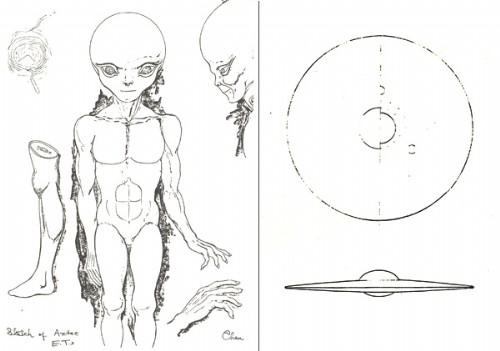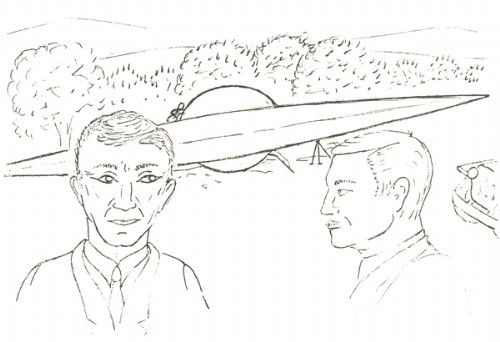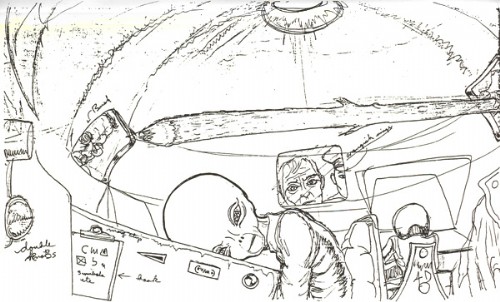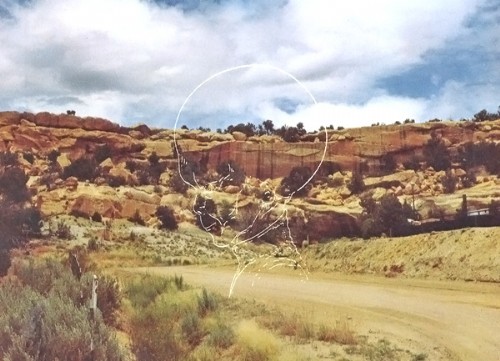Date:
March 25, 1948
Location: Aztec, New Mexico, United States
It
was the columnist Frank Scully who first alerted the world
to sensational stories of recovered flying saucers and
little men in his best-selling book Behind the Flying
Saucers published in 1950. Scully claimed that up to that
time there had been four such recoveries, one of which
was alleged to have taken place around Aztec, New Mexico,
when sixteen humanoid bodies were recovered together with
their undamaged craft.

Left: Artist's impression of the small bodies found
aboard the downed craft, based on
eyewitnesses' descriptions relayed through intermediary
contacts. (artist: Chan Johnson)
Right: Line drawing of the 100' diameter disc-shaped
craft. (source: Steinman/Stevens)

Artist's impression of the craft on the ground. Dr. Vannevar
Bush, team leader, and Dr. Jerome
Hunsaker, Aeronautical Engineer at MIT. (artist: Chan
Johnson; source: Steinman/Stevens)

A cabin window in the dome of the craft was broken out
and a pole thrust through which
tripped a release and an access port opened. Dead occupants
inside were found slumped
over elaborate control panels. (artist: Chan Johnson;
source: Steinman/Stevens)

Above the cliffs isthe rocky plateau upo which the UFO
crash landed. An artist's composite
drawing from descriptions fo the alien bodies recovered
overlays the foreground scene.
(source: Steinman/Stevens)
Source:
(Credit: aztecufo.com)
THE
AZTEC RECOVERY 1948
It
was the columnist Frank Scully who first alerted the world
to sensational stories of recovered flying saucers and
little men in his best-selling book Behind the Flying
Saucers published in 1950. Scully claimed that up to that
time there had been four such recoveries, one of which
was alleged to have taken place around Aztec, New Mexico,
when sixteen humanoid bodies were recovered together with
their undamaged craft. According to Scully's informants,
the disk that landed near Aztec was 99.99 feet in diameter,
its exterior made of a light metal resembling aluminum
but so durable that no amount of heat (up to 10,000 degrees
was applied) or diamond-tipped drill had the slightest
effect. The disk apparently incorporated large rings of
metal which revolved around a central, stabilized cabin,
using an unfamiliar gear ratio. There were no rivets,
bolts, screws or signs of welding. Investigators were
eventually able to gain entry. Scully was told, because
of a fracture in one of the portholes, which they enlarged,
revealing a knob inside the cabin which when pushed (with
a pole) caused a hidden door to open. Sixteen small humanoids,
ranging in height from 36 to 42 inches, were supposedly
found dead inside the cabin, their bodies charred to a
dark brown color. Scully was told that the craft landed
undamaged, having landed under its own guidance. The craft
was eventually dismantled, the investigators having discovered
that it was manufactured in segments which fitted in grooves
and were pinned together around the base. The complete
cabin section, measuring 18 feet in diameter was lifted
out of the base of the saucer, around which was a gear
that fitted a gear on the cabin. These segments, together
with the bodies, were then transported to Wright Field
(Wright Patterson AFB). Some of the bodies were later
dissected and examined by the Air Force, and were found
to be similar in all respects to human beings, with the
exception of their teeth, which were perfect.
New
Supportive Evidence?
According
to important information published by William Steinman
in 1987 there is a large grain of truth in the Aztec story,
and he has managed to acquire some astonishing supportive
evidence. Like Scully, he is unwilling to divulge his
sources, which inevitably lays him open to charges of
fabrication. Steinman discovered that the Aztec disk came
to earth on 25 March 1948, having been detected by three
separate radar units in the southwest, one of which was
said to have disrupted the craft's control mechanism.
The area of impact was calculated by triangulation and
this information was immediately relayed to Air Defense
Command and Gen. George C. Marshall, then Secretary of
State, who allegedly contacted the MJ-12 group as well
as the Interplanetary Phenomenon Unit (IPU) of the Army
Counterintelligence Directorate. The IPU operated out
of Camp Hale, Colorado, at this time, Steinman claims,
and its main function was to collect and deliver disabled
or crashed disks to certain specified secret locations.
The craft was recovered within hours by the IPU scout
team about 12 miles northeast of Aztec. General Marshall
ordered Air Defense Command to go off alert status, and
the radar units were advised that there had been a false
alarm. Marshall then gave orders to the commander of the
IPU to organize a recovery team and contacted Dr. Vannevar
Bush - the. head of MJ-12 to gather together a team of
scientists to accompany the IPU to the crash site. Steinman
has named these scientists as follows:
Dr.
Lloyd Berkner, Dr. Detlev Bronk, Dr. Carl A. Heiland,
Dr. Jerome Hunsaker, Dr. John von Neumann, Dr. Robert
J. Oppenheimer, Dr. Merle A. Tuve, Dr. Horace B. van Vandenberg.
Four
of these scientists, it will be noted, were members of
the original MJ-12 panel set up in September 1947. Dr.
Carl A. Heiland was a geophysicist and magnetic sciences
expert who was the head of the Colorado School of Mines,
and according to Steinman leaked details of the recovery
to one of Scully's sources, Leo GeBauer. Dr. Horace B.
van Vandenberg was an inorganic chemist associated with
the University of Colorado. Dr. Merle A. Tuve worked for
the Office of Scientific Research and Development during
World War II, and is chiefly remembered as a geophysicist
for his techniques of radio wave propagation of the upper
atmosphere. Dr. Robert J. Oppenheimer distinguished himself
primarily as leader of the Los Alamos atomic bomb project
, commanding the allegiance of the world's top physicists.
He was the Director of the Institute of Advanced Studies
at Princeton from 1947 and became Chairman of the General
Advisory Committee of the Atomic Energy Commission. Dr.
John von Neumann, the famous Hungarian born mathematician,
became a consultant on the atomic bomb (Manhatten Project)
in 1943. His main area of expertise lay in the design
and development of computers. The scientists, according
to Steinman, were told by Dr. Bush to assemble at Durango
Airfield, Colorado, 35 miles to the north of Aztec, with
the minimum delay. All those involved in the recovery
were sworn to an above top secret oath.
The
IPU convoy used a route to the site that avoided main
roads, and on arrival road blocks were set up at strategic
points within two miles of the recovery area. The owner
of a ranch and his family were allegedly held incommunicado
and told never to discuss the matter (cf. the Roswell
incident). Equipment hauling trucks were camouflaged to
look like oil drilling rigs during the operation.
Inside
the Craft
A
team of scientists arrived at the site a little later
than the IPU team and began dissecting the disk. According
to Steinman, they entered the craft one by one, entry
having been gained via a fractured porthole as described
in Scully's account. The portholes themselves looked metallic
and only appeared translucent on close inspection. Inside
the craft they found two humanoids, about two feet in
height, slumped over an instrument panel charred deep
brown. Another 12 bodies lay sprawled on the floor in
chamber within the cabin, making a total of 14 bodies
(not 16 as Scully had been told).
An
instrument panel supposedly had several pushbuttons and
levers with hieroglyphic-type symbols, as well as symbols
illuminated on small display screens. Bush and von Neumann
discovered that the control panel had drawers which rolled
out, but no wiring could be detected. A book composed
of parchment-like leaves with the texture of plastic also
contained the strange hieroglyphs - similar to Sanskrit,
Oppenheimer thought. This was given to General Marshall,
who then passed it on to two leading cryptological experts
for analysis, William F. Friedman and Lambros C. Callihamos
(who both later led distinguished careers in the National
Security Agency).
Dr.
Bronk, a physiologist and biophysicist, examined the bodies
and asked Bush to get hold of cryogenic equipment with
which to preserve them. Cryogenics specialist Dr. Paul
A. Scherer, a colleague of Bush's, was contacted and advised
Bush to obtain some dry ice. Meanwhile, another small
group of scientists and military personnel examined the
craft and were eventually able to dismantle it when several
interlocking key devices were found which opened up seams
at specific points.
Three
days later the segments were loaded onto three trucks,
together with the bodies, and transported with a tarpaulin
marked "Explosives". The convoy headed at night
by the least conspicuous and often most laborious route
to the restricted Naval Auxiliary Airfield Complex at
Los Alamos, arriving one week later. Here they remained
for over a year, Steinman claims, before being transported
to another base.
The
Bodies
Dr.
Paul A. Scherer eventually obtained special preservation
containers for the least damaged bodies, Steinman relates.
One of the companies which supplied equipment was the
Air Research Corporation, of which Scherer was Director
of Research and Development; it supplied the liquid nitrogen
pump, circulation system and refrigeration units. Other
specimens were given a complete autopsy, by a team headed
by Dr. Bronk, of biophysicists, histochemists and pathologists.
The results were put in a report, part of which, Steinman
claims, appeared in the "Air Force Project Sign (Grudge)
Report No. 13" which has never been released.
According
to the report, the bodies were described as averaging
42 inches in length. The facial features strongly resembled
"mongoloid Orientals" in appearance, with disproportionately
large heads, large "slant" eyes, small noses
and mouths. The average weight was about 40 pounds. The
torsos were very small and thin, with very thin necks.
The arms were long and slender, reaching the knees, with
hands containing long and slender fingers with webbing
between them. There was no digestive or gastrointestinal
tract, no alimentary or intestinal canal, and no rectal
point. No reproductive organs were apparent. Instead of
blood there was a colorless liquid with no red cells which
smelled similar to ozone.
--------------------------------------------------------------------------------
Further
Evidence
Veteran
researcher Leonard Stringfield, a former Air Force intelligence
officer who is the world's leading specialist on what
he calls "Retrievals of the Third Kind," shares
my misgivings about some of the material in Steinman's
book, but we are both impressed with his extensive research
into the Aztec case. Stringfield has uncovered further
evidence himself. Captain V. A. Postlethwait, who was
on detached service with Army G-2 (Intelligence) in 1948,
told Stringfield that he was cleared to see a top secret
cable describing the crash of a saucer-shaped craft 100
feet in diameter and 30 feet high, with one porthole broken,
causing suffocation to the five occupants - who had turned
blue as a result. The bodies were about four feet tall
with relatively large heads, Postlethwait recollects.
The metallic skin of the saucer was too tough to penetrate,
although as thin as newspaper. The incident was said to
have occurred near White Sands, New Mexico. Aside from
a few discrepancies there are some significant parallels
with the Aztec case. Postlethwait revealed to Stringfield,
for example, that private property was purchased to facilitate
transporting the craft.
Leonard
Stringfield has also spoken with Dr. Robert Spencer Carr,
a retired University of South Florida professor who claims
to have testimonial evidence from five sources, including
a nurse and a high-ranking Air Force officer who participated
in the recovery of a crashed UFO and occupants in 1948
- presumed to be the one at Aztec (although there was
another alleged recovery that year, just across the Mexican
border near Laredo, Texas). In 1982 Stringfield asked
Carr to disclose the name of his principal source, "on
the premise that our ages give us little time tolerance
in our search for truth."
"When
Professor Carr named his source," says Stringfield,
"I sat back dumbfounded. I knew his name well
in research, and recalled some of his comments on UFOs
while he served as an Air Force officer. . . . "Please,
Len," pleaded Carr, "keep the name to yourself;
please spare me any trouble as long as I live . . . My
key witness participated in the 1948 retrieval and saw
alien bodies on location."
According
to Bill Steinman, two of Carr's sources were aeronautical
engineers who provided important information regarding
the saucer's construction and propulsion. A source now
named is Arthur Bray (not to be confused with the Canadian
researcher), a security guard involved with the recovery
project. Carr also interviewed a woman whose father was
present during the recovery. Information pertaining to
the flying saucers must be suppressed, he told his daughter.
"If news of this vehicle's water-driven engine got
out to the whole scientific community, that would be the
end of the oil industry." The comment is of course
pure hearsay, but if there is any truth in it a further
possible reason for the cover-up is brought to light.
At
the still fenced-off crash site on a plateau twelve miles
northeast of Aztec, Bill Steinman has uncovered charred
and scraped-off rocks of various sizes as well as some
metal bracing struts that might possibly have been used
for supporting the craft. On one of his visits to the
area he was shadowed by two unmarked helicopters.
As
for George Bowra's claim that no one in Aztec, could recall
the incident, Steinman has traced at least four people
who knew where the crash site was located, one of whom,
"V.A.," recalls that sometime between 1948 and
1950 a huge disk-shaped flying object with a dome on top
skimmed about 100 feet above the ground not far from him.
The witness pointed out to Steinman a cliff jutting above
the Animas River.
"That
thing, or flying saucer, tried hard to clear that cliff,
but it hit the very corner up there, shooting sparks and
rocks in every direction," he claims. "Finally,
it made a right-angle turn in midair and headed straight
north in the direction of the alleged crash site at Hart
Canyon. That's the last I saw of it. I ran into the house
and called the military in Albuquerque. I never heard
from them about it."
Steinman
first became interested in UFOs in 1981 when he read Frank
Scully's book, and has since devoted much of his time
and resources on the Aztec case and the other recoveries
associated with Scully's claims, often in the face of
discouraging odds. Steinman's job in quality assurance
and analysis in the aerospace industry has aided him in
probing the complex and intricate leads that he has pursued.
Writing
in the foreword to Steinman's book, UFO Crash at Aztec,
Leonard Stringfield explains how, like many others, he
was led to believe the Scully story was a hoax, his disbelief
long being conditioned by a succession of ufologists who
for years claimed that Scully "was duped by a scheming
Silas Newton and his cohort, Leo Gebauer." But now,
thanks to Bill Steinman's painstaking research (as well
as some of his own leads), he has been obliged to reevaluate
the evidence.
Source:
http://www.ufoevidence.org/cases/case879.htm
